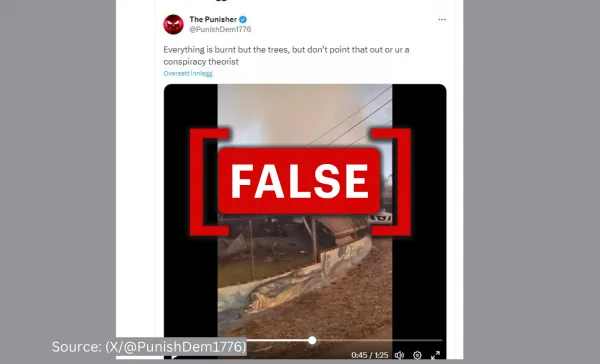By: John Faerseth
August 16 2023
A video showing trees and plants surviving Hawai’i wildfires does not mean the fires were fake

Trees in Maui
The Verdict False
Many plants and trees can survive intense fires, and fire patterns differ. There is no evidence the Hawai'i wildfires were staged.
Context
A viral X (formerly Twitter) post claims a hidden conspiracy is to blame for the wildfires in Hawai'i. The caption reads, "Everything is burnt but the trees, but don't point that out or ur a conspiracy theorist." The short clip shows smoke, burned cars and buildings, and some burned trees. Other trees are still standing, apparently untouched by the fire. The user doubles down on various conspiracy theories in replies to their post, suggesting the wildfires were a "false flag" and that "Community notes didn't explain how fires turned concrete into powder."
The post does not provide a theory as to why this happened, but the author says he does not buy the official story.
In fact
The clip is from ABC News; a Lahaina, West Maui resident originally submitted the video featured in the news report. It shows a group of people driving through neighborhoods where fires have razed the area.
According to U.S. Fire Administrator Lori Moore-Merrell, the fire that destroyed the historic town of Lahaina is now the deadliest U.S. blaze in over 100 years. The fires began on August 8, 2023, and have so far resulted in 96 people dying, with many more missing.
The ignition of the fires is still under investigation. According to the U.S. drought monitor, about 14 percent of the state is suffering from severe or moderate drought, while 80 percent of Hawai'i is classed as abnormally dry. Maui was under a red flag alert before the first fires broke out, signifying an increased risk of danger. Scientists have also noted that parts of Hawai'i are covered with non-native grasses that are more flammable than native plants.
Trees have layers of thick bark that protect the tree's phloem – the plant's vascular tissue – which moves food substances around the tree, supporting growth and seed production. Some trees also release a sticky substance called sap, which flows into cracks where fire could otherwise reach the phloem. This leaves the tree with a fire scar, but it may otherwise survive and keep growing. Trees may also use both strategies, as seen in the ponderosa pine forests in parts of the southwestern U.S.
Trees may also adapt to survive fires by growing tall crowns and fewer lower branches, making it difficult for the fire to climb to higher limbs and allow trees to keep their leaves and vital growth tissues above the reach of the flames. Trees left standing after a fire often have one or more adaptations, although they will eventually succumb to intense fires.
Nathan Gill, assistant professor at the University of Texas, explains to Logically Facts that some Hawai'ian trees do shed their lower branches in this manner but not necessarily as an adaptation to fire. He believes the reason some trees in the video appear to have survived has more to do with the distribution of different plant species in the landscape or wind direction than the adaptations of the trees.
"It is very common to have patches of trees and other plants that either burned at low severity or didn't burn at all, even within the perimeter of very intense fires. For example, even during the 1988 Yellowstone Fires, acclaimed for being very large and severe, there was a rich pattern of burning at different severities. This patchy burning tends to be the rule, not the exception. Sometimes you'll get very large patches where 100 percent of trees are killed, but even the most intense fires don't burn that way throughout the entire fire perimeter."
Stephanie Yelenik, a rangeland scientist in the US Forest Service, told Logically Facts that Hawai'i is not known to have fire-adapted forests in the traditional sense, although many species may come back strong from seeds or resprouting after a fire. Even fire-adapted species may die from high-intensity fires like the one around Lahaina.
"However, the land around Lahaina does not, to my knowledge, have any native trees, shrubs, or grasses. It was mostly invasive grasses, which are a legacy of past land use for sugarcane production that cleared the land and probably lowered soil quality, as well as of grazing which introduced invasive grass species to the islands that carry fire very easily."
Residents have also expressed concern about Lahaina's historical Banyan tree, planted in 1873 in what was once the capital for the then-Kingdom of Hawai'i. It has since become a landmark and a community gathering space. Eyewitness accounts state that the banyan tree remains standing and appears to have withstood the flames, although experts worry that the heat of the fire could bring an end to the 150-year-old tree, which is a non-native species lacking natural defenses against flames. Trees may initially survive a fire but succumb to fire-induced damage later.
The verdict
Despite a video showing many trees and plants still standing after extreme wildfires caused extensive damage in Hawai'i, this does not mean the wildfires were staged. Many plants have adapted in various ways to survive fires, and the distribution of plant species and wind direction and strength are also factors. We have therefore marked this claim as false.


